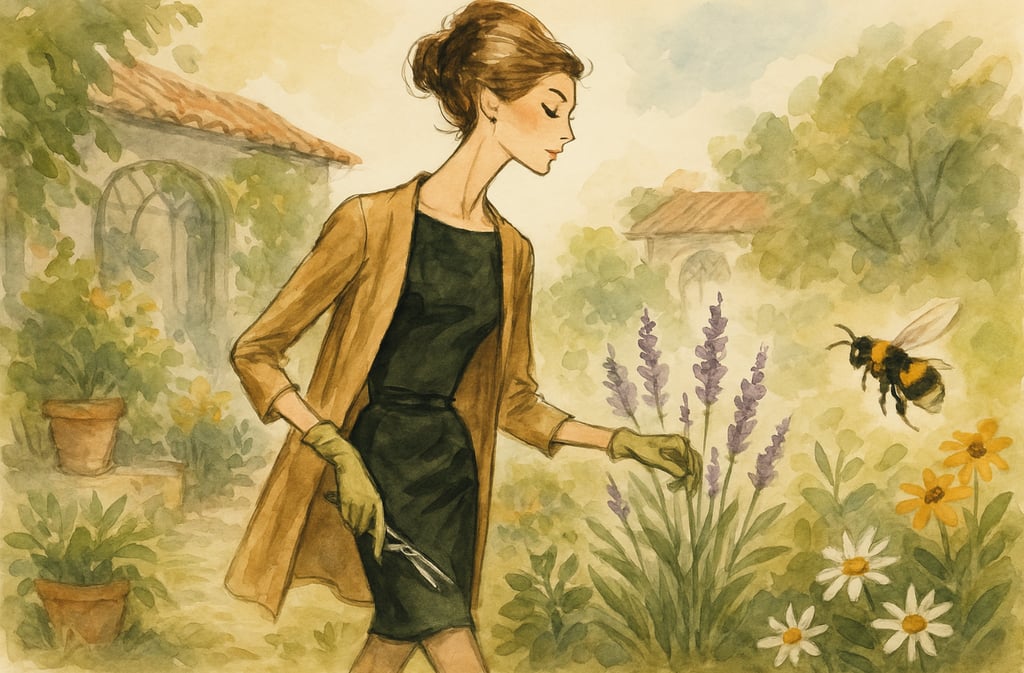How to Create a Pollinator-Friendly Garden (Without Inviting Pests Inside)
Create a bee-friendly garden that stays balanced. Use herbs and folk wisdom to welcome pollinators and keep pests away naturally.
ECO


A Garden Alive, But Not Overrun
At Hida Dream Home, summer hums. Bees roll lazily through lavender stalks, butterflies tumble over fennel, and ladybirds curl into the folds of rose petals like rubies on silk. It’s the kind of living garden we all want — alive, soft, balanced.
But life, when left unchecked, spills past the hedges. Mosquitoes gather near still water, ants march in long, silent processions toward the pantry, and moths slip like ghosts into the wardrobe.
In older villages, this was never solved with chemical sprays or neon-blue zappers. Instead, it was solved with balance — the right plants, gentle rituals, and old-world boundaries that honoured the creatures without letting them take over.
Why Balance Matters More Than Control
A thriving garden needs pollinators. Without bees and butterflies, herbs go unseeded, tomatoes stay green, and fruit trees struggle to set. But every thriving ecosystem has its shadows: flies, wasps, moths, and mosquitoes.
The folk approach is simple: invite the right guests, nudge the others away.
No toxic sprays (which kill pollinators and upset the soil).
No harsh fragrances (which linger on your food and fabrics).
Just plants, smoke, and kitchen-shelf wisdom to keep harmony.
Plants That Welcome Pollinators (But Not Pests)
Not every nectar-rich bloom brings chaos. These plants feed the bees while discouraging unwanted guests:
Lavender & Rosemary – Bees adore the flowers, but moths, flies, and mosquitoes avoid their oils. Plant along borders and near windows for both beauty and gentle defence.
Calendula (Pot Marigold) – Beloved by bees but disliked by some garden pests, especially aphids when interplanted.
Borage – A magnet for pollinators. Its cucumber-scented leaves have a natural insect-deterring note.
Chives & Alliums – Their flowers feed pollinators, while their scent helps discourage soft-bodied insects like aphids.
Folk Tip: Many older homesteads grew borage near beehives. The bees thrived, but wasps tended to stay away.
Controlling Mosquito Havens Without Chemicals
Standing water is a mosquito nursery. To discourage them:
Add a small fountain or bubbler to ponds — moving water disrupts mosquito breeding.
Toss in a few sprigs of rosemary or thyme — their oils gently deter mosquito larvae without harming fish.
If you have rain barrels, cover them with mesh or floating herb bundles.
Herb Borders: Nature’s Thresholds
Old-world gardens were built like small fortresses — not with fences, but with herbal sentinels. These borders did double duty: they smelled beautiful and kept pests outside.
Mint & Basil – Pot them by entrances and kitchen doors. Their scents confuse flies and ants. (Keep mint contained; it loves to roam.)
Sage & Thyme – Perfect for low hedges along paths. Their strong aromas slow crawling insects before they reach your home.
Bay Laurel – A single potted bay tree by a threshold is said to “guard the door” against both spirits and crawling pests.
Folk Lore: In some Balkan villages, a sprig of sage or bay was hung over doors during summer, believed to keep both flies and “bad winds” (illness) from crossing the threshold.
The Wardrobe Garden (Protecting Fabric the Old Way)
Before synthetic mothballs, families kept bundles of dried herbs and cedar chips in every cupboard. These weren’t only protective — they were fragrant blessings.
Make your own by filling small muslin sachets with:
Dried lavender (repels moths and soothes dreams).
Cedar shavings (repels insects naturally).
A pinch of thyme or rosemary (for added strength).
Tuck them into drawers, shelves, and wardrobes. Replace every 2–3 months.
Smoke and Rituals at the Edges
Where sprays now dominate, smoke once ruled.
At twilight, families would burn:
Rosemary sprigs – To drive away mosquitoes and cleanse lingering energy.
Pine needles – Their resinous smoke kept biting insects off porches.
Lavender stems – Sweet smoke to calm and repel.
This wasn’t fumigation; it was invitation and clearing. The smoke wove through thresholds, asking the unwanted to keep their distance while making the air feel alive again.
A Living Garden, Not a Battle
The folk way doesn’t wage war on nature. It listens, invites, and gently discourages.
With the right herbs, a touch of smoke, and small shifts in where and how things grow, you can have a pollinator paradise that doesn’t invade your pantry or your sleep.
Because a true homestead isn’t about control. It’s about living with everything — and keeping harmony with herbs, ritual, and a little wisdom passed down through the generations.
Read more on:
Buzz Off, Naturally: Folk Ways to Repel Insects Without Harsh Chemicals
Make Your Own Herbal Incense for Cleansing & Calm
Cottage Herb Gardens: Grow Lavender, Mint & Rosemary for Everyday Use
10 Folk Ways to Make Your Home Smell Fresh Naturally
